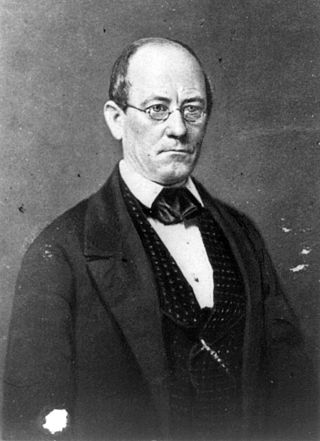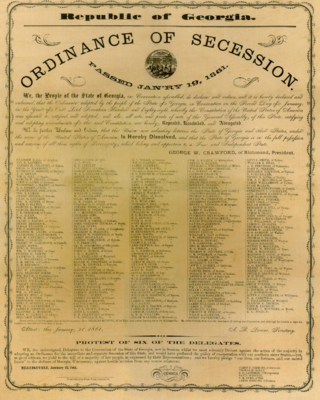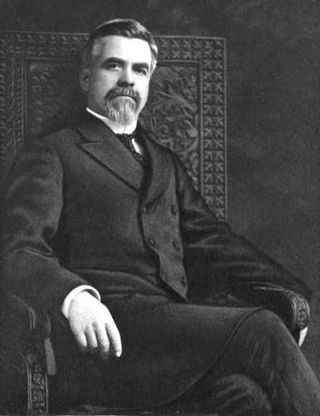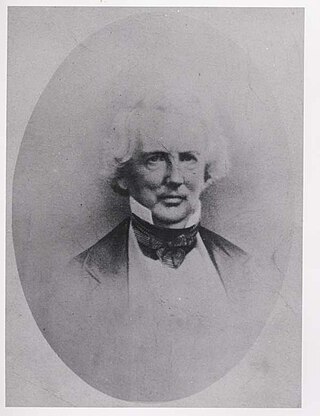
The Confederate States of America (CSA), commonly referred to as the Confederate States (C.S.), the Confederacy, or the South, was an unrecognized breakaway republic in the Southern United States that existed from February 8, 1861, to May 9, 1865. The Confederacy comprised eleven U.S. states that declared secession and warred against the United States during the American Civil War. The states were South Carolina, Mississippi, Florida, Alabama, Georgia, Louisiana, Texas, Virginia, Arkansas, Tennessee, and North Carolina.

Henry Carter Stuart was an American businessman and politician from Virginia. Between 1914 and 1918, he served as the 47th Governor of Virginia, a period which encompassed World War I.

John Letcher was an American lawyer, journalist, and politician. He served as a Representative in the United States Congress, was the 34th Governor of Virginia during the American Civil War, and later served in the Virginia General Assembly. He was also active on the Board of Visitors of Virginia Military Institute.

An Ordinance of Secession was the name given to multiple resolutions drafted and ratified in 1860 and 1861, at or near the beginning of the Civil War, by which each seceding Southern state or territory formally declared secession from the United States of America. South Carolina, Mississippi, Georgia, and Texas also issued separate documents purporting to justify secession.

The Virginia Conventions have been the assemblies of delegates elected for the purpose of establishing constitutions of fundamental law for the Commonwealth of Virginia superior to General Assembly legislation. Their constitutions and subsequent amendments span four centuries across the territory of modern-day Virginia, West Virginia and Kentucky.
The Ludlow Amendment was a proposed amendment to the Constitution of the United States which called for a national referendum on any declaration of war by Congress, except in cases when the United States had been attacked first. Representative Louis Ludlow (D-Indiana) introduced the amendment several times between 1935 and 1940. Supporters argued that ordinary people, who were called upon to fight and die during wartime, should have a direct vote on their country's involvement in military conflicts.

The American state of Virginia became a prominent part of the Confederacy when it joined during the American Civil War. As a Southern slave-holding state, Virginia held the state convention to deal with the secession crisis, and voted against secession on April 4, 1861. Opinion shifted after the Battle of Fort Sumter on April 12, and April 15, when U.S. President Abraham Lincoln called for troops from all states still in the Union to put down the rebellion. For all practical purposes, Virginia joined the Confederacy on April 17, though secession was not officially ratified until May 23. A Unionist government was established in Wheeling and the new state of West Virginia was created by an act of Congress from 50 counties of western Virginia, making it the only state to lose territory as a consequence of the war. Unionism was indeed strong also in other parts of the State, and during the war the Restored Government of Virginia was created as rival to the Confederate Government of Virginia, making it one of the states to have 2 governments during the Civil War.

Julian Minor Quarles was a lawyer, judge and United States Representative from Virginia to the 56th Congress.

In the United States, a state is a constituent political entity, of which there are 50. Bound together in a political union, each state holds governmental jurisdiction over a separate and defined geographic territory where it shares its sovereignty with the federal government. Due to this shared sovereignty, Americans are citizens both of the federal republic and of the state in which they reside. State citizenship and residency are flexible, and no government approval is required to move between states, except for persons restricted by certain types of court orders.

The 2012 Virginia State Elections took place on Election Day, November 6, 2012, the same day as the Presidential, U.S. Senate and U.S. House elections in the state. The only statewide elections on the ballot were two constitutional referendums to amend the Virginia State Constitution. Because Virginia state elections are held on off-years, no statewide officers or state legislative elections were held. Both referendums were referred to the voters by the Virginia General Assembly.

The 2006 Virginia State Elections took place on Election Day, November 7, 2006, the same day as the U.S. House and the U.S. Senate elections in the state. The only statewide elections on the ballot were three constitutional referendums to amend the Virginia State Constitution. Because Virginia state elections are held on off-years, no statewide officers or state legislative elections were held. All referendums were referred to the voters by the Virginia General Assembly.

The 1996 Virginia State Elections took place on Election Day, November 5, 1996, the same day as the presidential, U.S. Senate, and U.S. House elections in the state. The only statewide elections on the ballot were five constitutional referendums to amend the Virginia State Constitution. Because Virginia state elections are held on off-years, no statewide officers or state legislative elections were held. All referendums were referred to the voters by the Virginia General Assembly.

The 2016 Virginia State Elections took place on Election Day, November 8, 2016, the same day as the U.S. Presidential and U.S. House elections in the state. The only statewide elections on the ballot were two constitutional referendums to amend the Virginia State Constitution. Because Virginia state elections are held on off-years, no statewide officers or state legislative elections were held. The referendum was referred to the voters by the Virginia General Assembly.

The 1992 Virginia State Elections took place on Election Day, November 3, 1992, the same day as the U.S. Presidential and the U.S. House elections in the state. The only statewide elections on the ballot were one constitutional referendum to amend the Virginia State Constitution and three government bond referendums. Because Virginia state elections are held on off-years, no statewide officers or state legislative elections were held. All referendums were referred to the voters by the Virginia General Assembly.

The 1987 Virginia State Elections took place on Election Day, November 3, 1987, the same day as the elections to the Virginia House of Delegates and the Virginia Senate, which are always held in off-years. The only statewide election on the ballot was one referendum, which was referred to the voters by the Virginia General Assembly.

The 1988 Virginia State Elections took place on Election Day, November 8, 1988, the same day as the U.S. Senate and U.S. House elections in the state. The only statewide election on the ballot was one referendum. Because Virginia state elections are held on off-years, no statewide officers or state legislative elections were held. The referendum was referred to the voters by the Virginia General Assembly.

The 1978 Virginia State Elections took place on Election Day, November 7, 1978, the same day as the U.S. House elections in the state. The only statewide elections on the ballot were one constitutional referendums to amend the Virginia State Constitution and one statutory referendum. Because Virginia state elections are held on off-years, no statewide officers or state legislative elections were held. All referendums were referred to the voters by the Virginia General Assembly.

The Virginia Secession Convention of 1861 was called in the state capital of Richmond to determine whether Virginia would secede from the United States, govern the state during a state of emergency, and write a new Constitution for Virginia, which was subsequently voted down in a referendum under the Confederate Government.

The 2018 Virginia State Elections took place on Election Day, November 6, 2018, the same day as the U.S. Senate and U.S. House elections in the state. The only statewide election on the ballot were two constitutional referendums to amend the Virginia State Constitution. Because Virginia state elections are held on off-years, no statewide officers or state legislative elections were held. The referendum was referred to the voters by the Virginia General Assembly. The amendment easily passed, although final vote totals await the final certification of results by the state board of elections.










